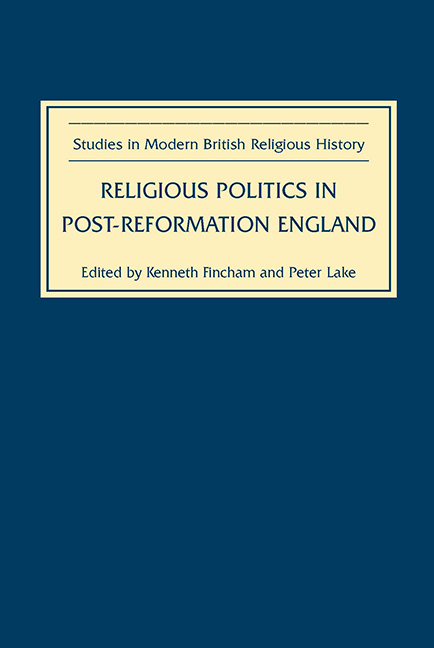Book contents
- Frontmatter
- CONTENTS
- Dedicaton
- Miscellaneous Frontmatter
- Preface
- Abbreviations
- 1 Introduction: Puritanism, Arminianism and Nicholas Tyacke
- 2 Art and Iconoclasm in Early Modern England
- 3 The Latitude of the Church of England
- 4 Joan of Contention: The Myth of the Female Pope in Early Modern England
- 5 Anti-Puritanism: The Structure of a Prejudice
- 6 The Fortunes of English Puritanism: An Elizabethan Perspective
- 7 What's in a Name? Dudley Fenner and the Peculiarities of Puritan Nomenclature
- 8 Puritan Preachers and their Patrons
- 9 New England's Reformation: ‘Wee shall be as a Citty upon a Hill, the Eies of All People are upon Us’
- 10 ‘Anglicanism’ by Stealth: The Career and Influence of John Overall
- 11 Destroyed for doing my Duty: Thomas Felton and the Penal Laws under Elizabeth and James I
- 12 Charles I and Providence
- 13 John Shawe and Edward Bowles: Civic Preachers at Peace and War
- 14 Material Evidence: The Religious Legacy of the Interregnum at St George Tombland, Norwich
- Index
- Tabula Gratulatoria
- Studies in Modern British Religious History
4 - Joan of Contention: The Myth of the Female Pope in Early Modern England
Published online by Cambridge University Press: 25 October 2017
- Frontmatter
- CONTENTS
- Dedicaton
- Miscellaneous Frontmatter
- Preface
- Abbreviations
- 1 Introduction: Puritanism, Arminianism and Nicholas Tyacke
- 2 Art and Iconoclasm in Early Modern England
- 3 The Latitude of the Church of England
- 4 Joan of Contention: The Myth of the Female Pope in Early Modern England
- 5 Anti-Puritanism: The Structure of a Prejudice
- 6 The Fortunes of English Puritanism: An Elizabethan Perspective
- 7 What's in a Name? Dudley Fenner and the Peculiarities of Puritan Nomenclature
- 8 Puritan Preachers and their Patrons
- 9 New England's Reformation: ‘Wee shall be as a Citty upon a Hill, the Eies of All People are upon Us’
- 10 ‘Anglicanism’ by Stealth: The Career and Influence of John Overall
- 11 Destroyed for doing my Duty: Thomas Felton and the Penal Laws under Elizabeth and James I
- 12 Charles I and Providence
- 13 John Shawe and Edward Bowles: Civic Preachers at Peace and War
- 14 Material Evidence: The Religious Legacy of the Interregnum at St George Tombland, Norwich
- Index
- Tabula Gratulatoria
- Studies in Modern British Religious History
Summary
During his interrogations in May 1558, the Marian martyr Roger Holland twice referred to the ‘fact’ that a woman had once reigned as pope in order to rebut his interrogators. Asked where the protestant Church was before Luther, Holland contemptuously answered ‘Our Church is not from Pope Nicholas or Pope Joane, but our Church is from the begynnyng, even from the time that God sayd unto Adam that the seede of the woman should breake the serpentes hed.’ The fact that Holland, an apprentice draper of London, was familiar with the story indicates how pervasively it had spread since its first appearance three centuries earlier. The fact that his interrogators let the ‘historical’ allusion pass unchallenged twice demonstrates the wide acceptance of the myth; it was not until four years after Holland's ashes littered Smithfield that the first serious critique of the story appeared.
The myth of the female pope, who came to be known as Pope Joan, circulated throughout Europe and was retold, and debated, for centuries. This essay will explore the reception of the story, and the controversies surrounding it, in England during the sixteenth and seventeenth centuries, at a time when the story of the female pope was ceaselessly discussed and disputed. The story of Pope Joan was related in such authoritative works as Foxe's ‘Book of Martyrs’ and John Jewel's Apologie. From 1563 onwards, the homily for Whitsunday denounced ‘Pope Jone the harlot’. Pope Joan was as ubiquitous a presence in Elizabethan and Jacobean controversial literature as she was in polemical literature under the later Stuarts.
The myth of Pope Joan is also a feature of one of the most important forces in early modern English political and religious life: anti-Catholicism. It coursed like a raging river through early modern England, carving its way through the landscape and sweeping everything before it. Of the three great political crises of the seventeenth century, two – the popish plot in 1678–81 and the Glorious Revolution of 1688–9 – were direct consequences of anti-Catholicism. The third, the civil war, was less directly, but still powerfully, shaped by the corrosive hatred and fear of Catholics. Linda Colley has famously maintained that protestantism played a crucial role in creating British national identity.
- Type
- Chapter
- Information
- Religious Politics in Post-Reformation England , pp. 60 - 79Publisher: Boydell & BrewerPrint publication year: 2006

